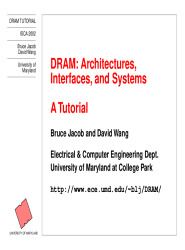DRAM: Architectures, Interfaces, and Systems
There are two technologies for manufacturing RAM: static and dynamic, they each have their field of application
The SRAM or Static RAM is the oldest. The bits y are memorized by electronic flip-flops whose production requires six transistors per bit to be memorized. The information remains stored until the component is switched on. The motherboards use an SRAM constructed in CMOS technology and equipped with a battery to keep the configuration data (setup) of the BIOS in a non-volatile manner. The circuit of this CMOS RAM is associated with the clock circuit which also needs the battery to operate continuously even when the computer is turned off. The SRAM is very fast and is for this reason the type of memory used for cache memories.
The DRAM for dynamic RAM is much simpler than the SRAM. This makes it possible to make components with a higher density and a lower cost.
Each bit of a DRAM is stored by an electrical charge stored in a small capacitor. This device offers the advantage of being very little bulky but has the disadvantage of not being able to keep the information for a long time. The capacitor discharges after a few milliseconds (ms). Also in order not to lose the bit of information it contains, a device is required which reads the memory and rewrites it to recharge the capacitors. These RAMs are called dynamic RAMs because this refresh operation must be repeated regularly.
Table of contents
- Basics
- DRAM organization
- Storage element
- Switching element
- DRAM Evolution: Structural Path
- Advanced Basics
- Bus transmission
- Memory controller
- Memory array
- Memory and CPU
- Data transfer
- Physical organization
- DRAM Evolution: Interface Path
- Read Timing for Conventional DRAM
- Read Timing for Fast Page Mode
- Future Interface Trends & Research Areas
- Performance Modeling:
- Architectures, Systems, Embedded
- Clocking Issues
- SDRAM Topology Example
- Access Protocol
- SDRAM Chip
- Technology Roadmap
- DRAM Configurations
- DDR2 Study Results
| Size : | 1,082.86 Kb |
| File type : | |
| Downloads: | 560 |
| Created: | 2016-12-31 |
Warning: Trying to access array offset on false in /home/tutovnfz/public_html/article.php on line 233
Others Memory Tutorials
Introduction to ARM Memory and Assembly Language
Others related eBooks about DRAM: Architectures, Interfaces, and Systems
Entity Framework Core SuccinctlyDownload free course Entity Framework Core Succinctly, pdf file on 111 pages by Ricardo Peres....
Central Processing Unit (CPU) TutorialWith this pdf training course, we will learn the basics of central processing unit of the computer, free tutorial intended to beginners....
Program Arcade GamesDownload free course Program Arcade Games, pdf file on 392 pages by Paul Craven....
Computer basics for beginnersA basic computer tutorial is a step-by-step guide that is designed to provide beginners with an understanding of the fundamental components and functionalities of a computer....
Computer basics coursesDownload free course material and training Computer basics on 17 pages intended to beginners....
Introduction to Computer ScienceThis PDF tutorial aimes to give students a basic introduction to computer science, computer hardware/software, programming language and compilers. Free training document course under 109 pages by Ryan Stansifer....
Help! My Computer is BrokenDownload free course Help! My Computer is Broken, pdf file on 144 pages by Barry Collins....
Computer Fundamentals courseWith this course, you will learn how a computer works, it introduces you to assembly-level programming. You will be able to write a simple assembly language program. At the end of the tutorial, you’ll be able to understand the different types of information which may be stored in a computer memory...
Basic Computer UsageYou will with this pdf tutorial the basics of computer sciences, installing software, running commandes and using files....
Computer and Information SciencesDownload free course Computer and Information Sciences, pdf file on 280 pages by Tadeusz Czachórski, Erol Gelenbe, Krzysztof Grochla, Ricardo Lent....
